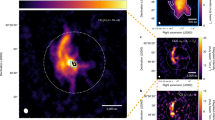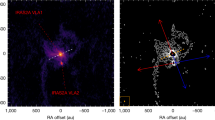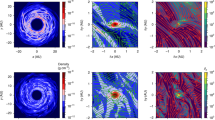Abstract
Understanding the formation of wide-binary systems of very low-mass stars (M ≤ 0.1 solar masses, M⊙) is challenging1,2,3. The most obvious route is through widely separated low-mass collapsing fragments produced by turbulent fragmentation of a molecular core4,5. However, close binaries or multiples from disk fragmentation can also evolve to wide binaries over a few initial crossing times of the stellar cluster through tidal evolution6. Finding an isolated low-mass wide-binary system in the earliest stage of formation, before tidal evolution could occur, would prove that turbulent fragmentation is a viable mechanism for (very) low-mass wide binaries. Here we report high-resolution ALMA observations of a known wide-separation protostellar binary, showing that each component has a circumstellar disk. The system is too young7 to have evolved from a close binary, and the disk axes are misaligned, providing strong support for the turbulent fragmentation model. Masses of both stars are derived from the Keplerian rotation of the disks; both are very low-mass stars.
This is a preview of subscription content, access via your institution
Access options
Access Nature and 54 other Nature Portfolio journals
Get Nature+, our best-value online-access subscription
$29.99 / 30 days
cancel any time
Subscribe to this journal
Receive 12 digital issues and online access to articles
$119.00 per year
only $9.92 per issue
Buy this article
- Purchase on Springer Link
- Instant access to full article PDF
Prices may be subject to local taxes which are calculated during checkout




Similar content being viewed by others
References
Béjar, V. J. S. et al. Discovery of a wide companion near the deuterium-burning mass limit in the Upper Scorpius association. Astrophys. J. Lett. 673, L185 (2008).
Luhman, K. L., Mamajek, E. E., Allen, P. R., Muench, A. A. & Finkbeiner, D. P. Discovery of a wide binary brown dwarf born in isolation. Astrophys. J. 691, 1265–1275 (2009).
Luhman, K. L. The formation and early evolution of low-mass stars and brown dwarfs. Annu. Rev. Astron. Astrophys. 50, 65–106 (2012).
Goodwin, S. P., Whitworth, A. P. & Ward-Thompson, D. Simulating star formation in molecular cloud cores. I. The influence of low levels of turbulence on fragmentation and multiplicity. Astron. Astrophys. 414, 633–650 (2004).
Fisher, R. T. A turbulent interstellar medium origin of the binary period distribution. Astrophys. J. 600, 769–780 (2004).
Marks, M. & Kroupa, P. Inverse dynamical population synthesis. Constraining the initial conditions of young stellar clusters by studying their binary populations. Astron. Astrophys. 543, A8 (2012).
Dunham, M. M. et al. The Spitzer c2d survey of nearby dense cores. I. First direct detection of the embedded source in IRAM 04191+1522. Astrophys. J. 651, 945–959 (2006).
Offner, S. S. R., Kratter, K. M., Matzner, C. D., Krumholz, M. R. & Klein, R. I. The formation of low-mass binary star systems via turbulent fragmentation. Astrophys. J. 725, 1485–1494 (2010).
Kratter, K. M., Matzner, C. D., Krumholz, M. R. & Klein, R. I. On the role of disks in the formation of stellar systems: a numerical parameter study of rapid accretion. Astrophys. J. 708, 1585–1597 (2010).
Bate, M. R. Stellar, brown dwarf and multiple star properties from a radiation hydrodynamical simulation of star cluster formation. Mon. Not. R. Astron. Soc. 419, 3115–3146 (2012).
Dunham, M. M . et al. in Protostars and Planets VI (ed. Beuther, H ., Klessen, R. S ., Dullemond, C. P . & Henning, T. ) 195–218 (Univ. Arizona Press, 2014).
Tobin, J. J. et al. The VLA Nascent Disk and Multiplicity survey of Perseus protostars (VANDAM). II. Multiplicity of protostars in the Perseus molecular cloud. Astrophys. J. 818, 73 (2016).
Tobin, J. J. et al. A triple protostar system formed via fragmentation of a gravitationally unstable disk. Nature 538, 483–486 (2016).
Pineda, J. E. et al. The formation of a quadruple star system with wide separation. Nature 518, 213–215 (2015).
Offner, S. S. R., Dunham, M. M., Lee, K. I., Arce, H. G. & Fielding, D. B. The turbulent origin of outflow and spin misalignment in multiple star systems. Astrophys. J. Lett. 827, L11 (2016).
Bonnell, I. A. & Bate, M. R. Massive circumbinary discs and the formation of multiple systems. Mon. Not. R. Astron. Soc. 269, L45–L48 (1994).
Lee, J. W. Y., Hull, C. L. H. & Offner, S. S. R. Synthetic observations of magnetic fields in protostellar cores. Astrophys. J. 834, 201 (2017).
Jensen, E. L. N., Mathieu, R. D., Donar, A. X. & Dullighan, A. Testing protoplanetary disk alignment in young binaries. Astrophys. J. 600, 789–803 (2004).
Jensen, E. L. N. & Akeson, R. Misaligned protoplanetary disks in a young binary star system. Nature 511, 567–569 (2014).
Salyk, C. et al. ALMA Observations of the T Tauri binary system AS 205: evidence for molecular winds and/or binary interactions. Astrophys. J. 792, 68 (2014).
Williams, J. P. et al. ALMA observations of a misaligned binary protoplanetary disk system in Orion. Astrophys. J. 796, 120 (2014).
Duchêne, G., Bouvier, J., Bontemps, S., André, P. & Motte, F. Multiple protostellar systems. I. A deep near infrared survey of Taurus and Ophiuchus protostellar objects. Astron. Astrophys. 427, 651–665 (2004).
Luhman, K. L., Allen, P. R., Espaillat, C., Hartmann, L. & Calvet, N. the disk population of the Taurus star-forming region. Astrophys. J. Suppl. 186, 111–174 (2010).
Connelley, M. S., Reipurth, B. & Tokunaga, A. T. The evolution of the multiplicity of embedded protostars. I. Sample properties and binary detections. Astron. J. 135, 2496–2525 (2008).
Dang-Duc, C., Phan-Bao, N. & Dao-Van, D. T. Two confirmed class I very low-mass objects in Taurus. Astron. Astrophys. 588, L2 (2016).
Bulger, J. et al. The Taurus Boundary of Stellar/Substellar (TBOSS) Survey. I. Far-IR disk emission measured with Herschel. Astron. Astrophys. 570, A29 (2014).
Tobin, J. J. et al. A ∼0.2-solar-mass protostar with a Keplerian disk in the very young L1527 IRS system. Nature 492, 83–85 (2012).
Young, C. H. et al. Submillimeter Common-User Bolometer Array mapping of Spitzer c2d small clouds and cores. Astron. J. 132, 1998–2013 (2006).
André, P., Motte, F. & Bacmann, A. Discovery of an extremely young accreting protostar in Taurus. Astrophys. J. Lett. 513, L57–L60 (1999).
Rebull, L. M. et al. The Taurus Spitzer Survey: new candidate Taurus members selected using sensitive mid-infrared photometry. Astrophys. J. Suppl. 186, 259–307 (2010).
Kroupa, P. Inverse dynamical population synthesis and star formation. Mon. Not. R. Astron. Soc. 277, 1491–1506 (1995).
McMullin, J. P., Waters, B., Schiebel, D., Young, W. & Golap, K. in Astronomical Data Analysis Software and Systems XVI (eds Shaw, R. A., Hill, F. & Bell, D. J.) Astronomical Society of the Pacific Conference Series Vol. 376, 127 (2007).
Andrews, S. M. & Williams, J. P. Circumstellar dust disks in Taurus–Auriga: the submillimeter perspective. Astrophys. J. 631, 1134–1160 (2005).
Acknowledgements
This paper makes use of the following ALMA data: ADS/JAO.ALMA#2013.1.00537.S and 2015.1.00186.S. ALMA is a partnership of the European Southern Observatory (representing its member states), the National Science Foundation (United States) and National Institutes of Natural Sciences (Japan), together with the National Research Council (Canada), the National Science Council and Academia Sinica Institute of Astronomy and Astrophysics (Taiwan), and Korea Astronomy and Space Science Institute (KASI, Republic of Korea), in cooperation with the Republic of Chile. The Joint ALMA Observatory is operated by ESO, AUI/NRAO and NAOJ. J.-E.L. was supported by the Basic Science Research Program through the National Research Foundation of Korea (NRF) (grant no. NRF-2015R1A2A2A01004769) and KASI under the R&D program (project no. 2015-1-320-18) supervised by the Ministry of Science, ICT and Future Planning. N.J.E. thanks KASI for support for a visit to participate in this work.
Author information
Authors and Affiliations
Contributions
J.-E.L. and S.L. performed the detailed calculations used in the analysis. S.L. and K.T. reduced the ALMA data. J.-E.L. wrote the manuscript. All authors were participants in the discussion of results, determination of the conclusions and revision of the manuscript.
Corresponding author
Ethics declarations
Competing interests
The authors declare no competing financial interests.
Supplementary information
Supplementary Information
Supplementary Figures 1–3 and Supplementary Tables 1–3. (PDF 183 kb)
Rights and permissions
About this article
Cite this article
Lee, JE., Lee, S., Dunham, M. et al. Formation of wide binaries by turbulent fragmentation. Nat Astron 1, 0172 (2017). https://doi.org/10.1038/s41550-017-0172
Received:
Accepted:
Published:
DOI: https://doi.org/10.1038/s41550-017-0172



